Article
Simple prostatectomy for BPH: Surgeons demonstrate robotic approaches
These videos illustrate a robotic solution to the complex problem of very large prostate glands causing severe lower urinary tract symptoms.
These videos illustrate a robotic solution to the complex problem of very large prostate glands causing severe lower urinary tract symptoms. Although many approaches have been employed to treat men with glands over 100 grams, such as serial transurethral resections, holmium laser enucleation, holmium laser ablation, and open simple prostatectomy, the widespread adoption of and comfort with robotic surgery among urologists makes the robotic simple prostatectomy an attractive option. Here, the authors illustrate the finer points of this surgery and demonstrate how to achieve optimal outcomes.
Commentary on the videos is provided by Stephen Summers, MD, assistant professor of surgery (urology), University of Utah, and 'Y'tube Section Editor James M. Hotaling, MD, MS, assistant professor of surgery (urology) at the Center for Reconstructive Urology and Men's Health, University of Utah, Salt Lake City.
Robot-assisted suprapubic simple prostatectomy: Step-by-step approach - Nicholas R. Rocco, MD, Michael G. Santomauro, MD, and colleagues
Simple prostatectomy can be performed via a suprapubic or retropubic approach using an open or minimally invasive technique. Given the three-dimensional visualization, operative field magnification, and improved laparoscopic tissue handling with wristed instruments, the robot-assisted approach is increasing as the chosen technique by many urologists. This video illustrates a safe and effective way to treat a large-volume prostate causing obstructive lower urinary tract symptoms.
Dr. Summers: The posterior approach without taking down the bladder has the advantage of preserving the space of Retzius. This is a consideration should the patient ever need a radical prostatectomy for cancer. The approach is quick, and closure of the bladder at the conclusion of the procedure is easy. Surgeons use retraction sutures anchored to the peritoneum to aid in visualization. A suture placed in the adenoma for traction is also helpful and facilitates use of the third arm for exposure. In my opinion, the disadvantage of this approach is slightly inferior visualization during the enucleation, as one’s camera is limited within the bladder. Overall, the surgeons from the Naval Medical Center demonstrate a technique that is easily learned for dealing with large prostate glands.
Dr. Hotaling: Here the authors employ a posterior approach in combination with retraction sutures anchored to the peritoneum as well as a traction suture in the adenoma to optimize exposure. One of the main advantages of this technique is its reproducibility and the strict adherence to anatomic planes in the exposure, dissection, and enucleation of the gland.


Robotic simple suprapubic prostatectomy for large prostatic adenoma - Michael Lao, MD, Jacob A. Baber, MD, and Joseph R. Wagner, MD
Many treatment options exist for the management of BPH. For patients with large glands, simple prostatectomy should be considered. This video depicts a minimally invasive robotic approach for a large symptomatic prostatic adenoma with bladder calculi.
Dr. Summers: Surgeons from the University of Connecticut have a similar approach to the robotic simple prostatectomy familiar to most urologists. Concurrent removal of bladder stones or repair of a diverticulum is easily combined with this approach when the retropubic space is developed. The use of traction sutures passed through the abdominal wall with an endoscopic closure device is a quick technique demonstrated here. Personally, I find the pigtail ureteral stents too cumbersome during the enucleation, as they often get in the way. Most of the time, one can see the ureteral orifice and avoid a stent altogether. As shown, a large prostate adenoma may need division prior to complete enucleation. It is easy to place too much traction using a tenaculum, and these surgeons avoid that by maintaining good visualization and dividing the adenoma when dissecting the apex. Retrigonization is accomplished with interrupted vicryl sutures. The series of simple prostatectomies from this group mimics our experience with favorable postoperative outcomes and minimal complications.
Dr. Hotaling: One of the main advantages of the robotic approach is the ease with which concurrent procedures can be performed. Here, the authors show how clear visualization is critical to performing these procedures. They also illustrate the use of stents to help identify the ureteral orifice, which can help to minimize complications.



Robotic simple prostatectomy: Patient selection, key steps - Stephen Summers, MD, and Ross Anderson, MD
Men with prostate glands >80-100 grams pose a unique challenge to urologists. Traditionally these men were treated with an open simple prostatectomy, but this operation has several risks and many urologists are reluctant to perform the procedure. Urologists are more facile with robotic procedures, and this video introduces several techniques for treating large prostates with a robot-assisted simple prostatectomy. Patient selection, key steps of the operation, and troubleshooting potential complications are reviewed.
Dr. Hotaling: This group uses a methodical and systematic approach to remove the adenoma. They initially release any adhesions and then develop the cystotomy site, open the bladder, and identify the ureteral orifices. Next, they perform the posterior plane dissection and extend this laterally to locate the apex and “shoulders” of the ademoma. Once removed, they obtain hemostasis and close. They do not place a double J ureteral stent but do temporarily catheterize the ureteral orifices to confirm the location of the orifices. The main advantage of their technique is the excellent visualization it affords for the procedure.



Section Editor James M. Hotaling, MD, MSDr. Hotaling is assistant professor of surgery (urology) at the Center for Reconstructive Urology and Men's Health, University of Utah, Salt Lake City.
Subscribe to Urology Times to get monthly news from the leading news source for urologists.

















